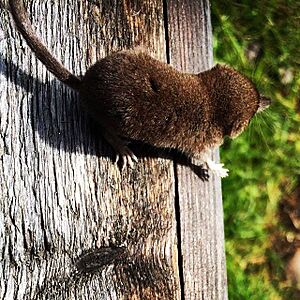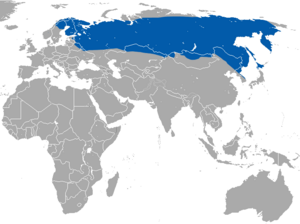Laxmann's shrew facts for kids
Quick facts for kids Laxmann's shrew |
|
|---|---|
 |
|
| Specimen with typical white feet (the brush tail is not shown) | |
| Conservation status | |
| Scientific classification | |
| Genus: |
Sorex
|
| Species: |
caecutiens
|
 |
|
| Laxmann's shrew range | |
The Laxmann's shrew (also known as Sorex caecutiens) is a small, furry animal belonging to the shrew family. You might also hear it called the masked shrew. These tiny creatures live across a huge area, from northern Scandinavia and the Baltic region all the way to the Sea of Japan. Their home includes places like Hokkaidō in Japan, Sakhalin Island, and the Korean Peninsula.
Laxmann's shrews usually prefer living in mountain forests. However, they can also be found in open, treeless areas called tundra or moorland. Sometimes, they even live in lower areas. They tend to stay away from farms or other land used by people.
Contents
Discovering the Laxmann's Shrew
This interesting shrew was first described in 1788. It was named by a Finnish-Swedish explorer and naturalist named Erik Laxmann. He gave it the scientific name Sorex caecutiens, which is why it's commonly known as Laxmann's shrew today. The first place where this shrew was officially found was southwest of Lake Baikal in Russia. Scientists have identified a few different types, or subspecies, of Laxmann's shrew.
What Does a Laxmann's Shrew Look Like?
An adult Laxmann's shrew is quite small. It usually weighs between 3 and 11 grams (about 0.1 to 0.4 ounces). Its body, from head to tail, is about 4.8 to 7.8 centimeters (1.9 to 3.1 inches) long. Its tail adds another 3.9 to 5.2 centimeters (1.5 to 2.0 inches) to its length.
This shrew has a long, thin snout. Unlike some other shrews, it doesn't have a pale stripe on the side of its snout. Its teeth have reddish tips, which helps scientists tell it apart from similar species. The fur of a Laxmann's shrew is shiny and has two different colors. Its feet are usually white. The tail is always more than half the length of its body. It often makes up more than 65% of its body length. The tail doesn't have long hairs, except for a small tuft right at the very tip.
Where Laxmann's Shrews Live
Laxmann's shrews live in the taiga zone, which is a type of forest found in cold northern regions. Their habitat stretches across northern Europe and Asia. You can find them from Norway and Sweden, through northern Siberia, to parts of China, Korea, Japan, and Sakhalin Island.
They are common in both mountain and lowland forests. They also live in the tundra areas next to these forests. These shrews prefer damp woodlands with lots of moss, thick bushes, and small trees. They also like to live near stream banks and the edges of swamps in moorland. As mentioned before, they avoid farmland.
Life and Habits of the Laxmann's Shrew
Laxmann's shrews are mostly active during the day. They mainly eat small invertebrates, which are animals without backbones. Their diet includes insects, especially beetles, as well as spiders, millipedes, and earthworms. If they can find them, they also eat conifer seeds.
These shrews have their young during the summer. A mother shrew can have up to four litters of babies in one summer. Each litter usually has 7 or 8 young, but can have anywhere from 2 to 11. The babies are born in an underground nest. Laxmann's shrews probably live for about one year.
Conservation Status
The Laxmann's shrew is found over a very large area. It is known to be quite common in many places where it lives. There aren't many major threats to this species. While some trees are cut down in their habitats, this doesn't seem to be a big problem for the shrews. The total number of Laxmann's shrews appears to be stable. Because of this, the International Union for Conservation of Nature (IUCN) has listed its conservation status as "least concern". This means they are not currently at risk of disappearing.
See also
- List of mammals of Finland
- List of mammals of Korea


